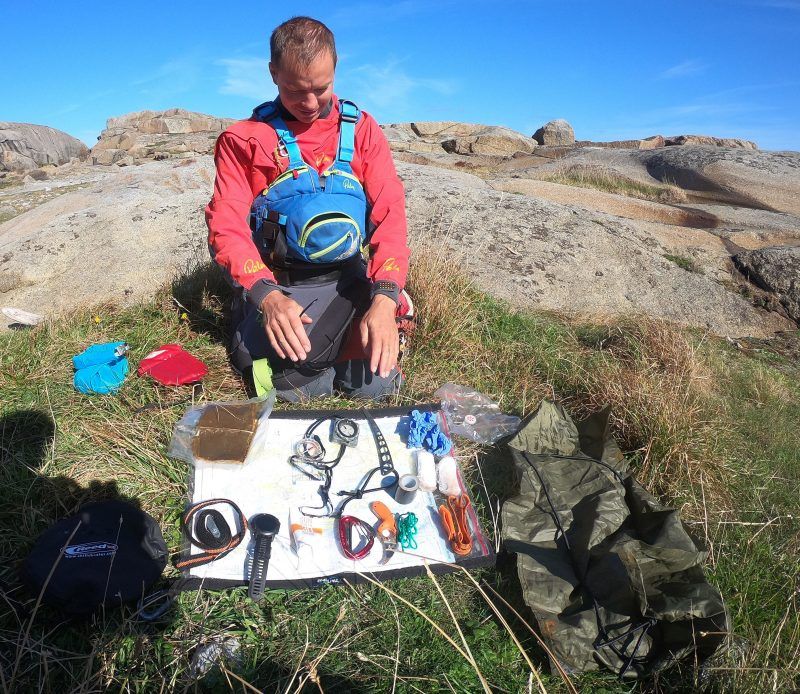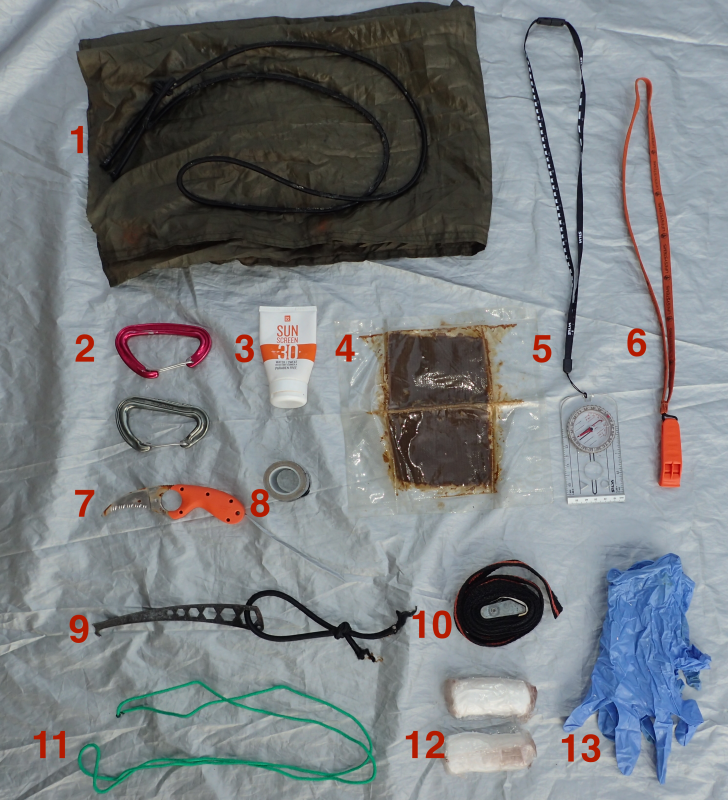There are some common boat problems you are better off being able to fix while on the water. Time, distance or conditions mean you do not always have the option of landing your kayak to fix a problem. Fishing out a repair kit from deep inside your hatch, might not be a robust solution either. Having well thought out solutions for common problems, should be available in your PFD. This gives you as a sea kayaker more operational leeway in a potentially sticky situation.
As a sea kayak guide and coach, I probably have some needs that differ from river or canoe paddlers. However, I have picked up valuable lessons from river and canoe paddlers and I think keeping an eye on what people from all paddle sports are doing is a good thing. The contents of my PFD is constantly evolving as I am picking up smart ideas from other paddlers. The stuff I have at the moment works well for me and I hope you can pick and choose what works for you.

Fixing common problems on the water is the first line of defense.
I have been using the Kaikoura and Extrem PFD. They both have plenty of pocket space for the equipment listed below.

- Tarp and bungee. In case a hatch is lost. Place the tarp around the hatch and tighten the bungee to make a temporary hatch cover.
- Spare karabiners. Used for coupling two kayaks together when one kayaker is, for whatever reason, unable to sit up straight in his/her kayak. These two kayaks can then be towed by one or two other kayakers. The carabiners also serve as spare carabiners in case the carabiner on the long-tow is lost.
- Sunscreen. Sooner or later the sun will become a first aid issue. Sunscreen should be handed out to anyone who forgets to bring it.
- Denso tape or Flashband. Denso tape is used by plumbers on leaking pipes while Flashband is used as roofing tape. They both work in a wet environment, which means you can apply these on a split kayak while on the water.
- Compass. There are many reasons why a compass needs to be ready to use. Finding out where you are by triangulation and taking a bearing are both necessary skills for sea kayakers.
- Whistle. Out at sea the noise level from the wind and the waves can become very loud. A whistle can more easily be heard compared to your voice.
- Cutting tool. Primarily to cut ropes in case of entanglement. The tool has a myriad of other uses as well, mostly on land while camping.
- Roll of tape. Gorilla tape or gaffer tape has a wide range of applications both on people and equipment.
- Nut tool. Originally from the world of climbing. This tool is used for getting a stuck skeg out. You can use it to get sand and tiny stones out from a stuck skeg. A much-used tool on courses and guided trips.
- Cam strap. A skeg can get stuck in the out position. This can be problematic when the kayaker wants to paddle up against the wind. To avoid this, tighten the strap around the kayak and the skeg to keep it in.
- A piece of string. Mostly used to tie two things together. Handy to have as a backup solution while on the water. This piece of equipment has a large number of applications.
- Bandages. To stop bleeding. When playing among rocks, both your hands and head are exposed to barnacles and sharp rocks. Bandages can be a temporary, quick fix while on the water. Band-aids typically do not work well in a wet environment and they do not store well in a constantly wet PFD.
- Rubber gloves. Cuts to the face or hands typically produces a significant amount of bleeding. Protecting yourself as a first aider is rule number one.
- Watch (attached to a shoulder strap). In addition to be able to tell what time it is, having a stopwatch allows you to micro-navigate in fog or in darkness. Assuming your paddling speed is 3 knots or 6 kilometres per hour, 1 minute of paddling equals 100 meters. Ten minutes will then equal about half a nautical mile or one kilometre. An hour will equal about 3 nautical miles or 6 kilometres. A stopwatch, compass and a map will then allow you to keep track of where you are, even though it is completely dark or foggy. Night navigation is a valuable skill, but also a unique outdoor experience.
- Navigation light. I have attached a red light on the shoulder strap of my PFD. Palm PFDs has a great little strap on the shoulder which allows you to fasten a small light. I’ve chosen a red light so as not to ruin the night vision of my fellow paddlers. Being visible at night is an obvious safety measure and so is maintaining night vision among my fellow paddlers.
Even better than carrying something for every eventuality is to be creative with what you have with you. Some equipment meant for fixing boats can also be used for fixing people. A karabiner, for example, can be used as one part in an improvised sling.
I hope this will be useful for any paddlers out there interested in temporary quick fixes on the water – Kristoffer